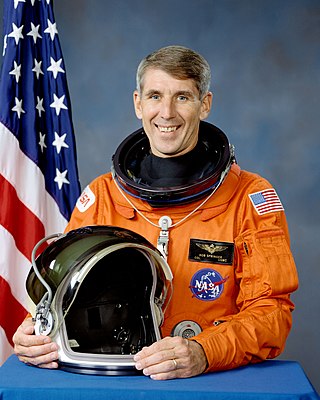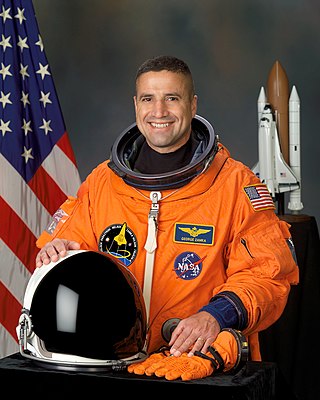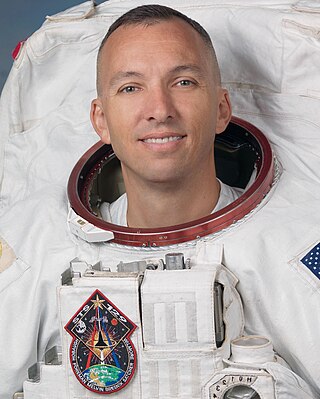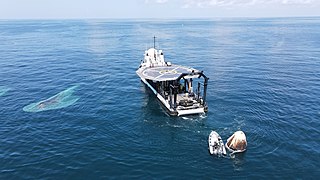
Robert Franklyn "Bob" Overmyer was an American test pilot, naval aviator, aeronautical engineer, physicist, United States Marine Corps officer, and USAF/NASA astronaut. Overmyer was selected by the Air Force as an astronaut for its Manned Orbiting Laboratory in 1966. Upon cancellation of the program in 1969, he became a NASA astronaut and served support crew duties for the Apollo program, Skylab program, and Apollo-Soyuz Test Project. In 1976, he was assigned to the Space Shuttle program and flew as pilot on STS-5 in 1982 and as commander on STS-51-B in 1985. He was selected as a lead investigator into the Space Shuttle Challenger disaster in 1986, retiring from NASA that same year. A decade later, Overmyer died while testing the Cirrus VK-30 homebuilt aircraft.

Robert Donald Cabana is a former Associate Administrator of the National Aeronautics and Space Administration (NASA), NASA astronaut and non-flight-eligible management astronaut), and is a veteran of four Space Shuttle flights. He served as Chief of the Astronaut Office from 1994 to 1997 and as director of the John F. Kennedy Space Center from 2008 to 2021. He is also a former naval flight officer and naval aviator in the United States Marine Corps.

Kenneth Donald Cameron, , is a retired American naval aviator, test pilot, engineer, U.S. Marine Corps officer, and NASA astronaut.

Charles Owen Hobaugh is a former NASA astronaut and a retired U.S. Marine Corps officer. He has had three spaceflights, all of which were Space Shuttle missions to the International Space Station, lasting between 10 and 13 days.

Bryan Daniel O'Connor is a retired United States Marine Corps Colonel and former NASA astronaut. He was inducted into the United States Astronaut Hall of Fame in 2008.

Robert Clyde "Bob" Springer is a retired American astronaut and test pilot who flew as a mission specialist on two NASA Space Shuttle missions in 1989 and 1990. A decorated aviator in the United States Marine Corps, Springer also flew more than 500 combat sorties during the Vietnam War. He has logged over 237 hours in space and 4,500 hours flying time, including 3,500 hours in jet aircraft.

Eric Allen Boe is a retired United States Air Force fighter pilot, Colonel, test pilot, and a current, active NASA astronaut. He flew as the pilot of Space Shuttle missions STS-126 and STS-133.

George David "Zambo" Zamka is a former NASA astronaut and United States Marine Corps pilot with over 3500 flight hours in more than 30 different aircraft. Zamka piloted the Space Shuttle Discovery in its October 2007 mission to the International Space Station and served as the commander of mission STS-130 in February 2010.

STS-130 was a NASA Space Shuttle mission to the International Space Station (ISS). Space ShuttleEndeavour's primary payloads were the Tranquility module and the Cupola, a robotic control station with six windows around its sides and another in the center, providing a 360-degree view around the station. Endeavour launched at 04:14 EST on February 8, 2010 and landed at 22:22 EST on February 21, 2010, on runway 15 at the Kennedy Space Center's Shuttle Landing Facility.

Katherine Megan McArthur is an American oceanographer, engineer, and NASA astronaut. She has served as a Capsule Communicator (CAPCOM) for both the Space Shuttle and International Space Station (ISS). Megan McArthur has flown one Space Shuttle mission, STS-125 and one SpaceX mission, SpaceX Crew-2 on Crew Dragon Endeavour. She is known as the last person to be hands on with the Hubble Space Telescope via the Canadarm. McArthur has served in a number of positions including working in the Shuttle Avionics Laboratory (SAIL). She is married to fellow astronaut Robert L. Behnken.

Randolph James "Komrade" Bresnik is a retired officer in the United States Marine Corps and an active NASA astronaut. A Marine Aviator by trade, Bresnik was selected as a member of NASA Astronaut Group 19 in May 2004. He first launched to space on STS-129, then served as flight engineer for Expedition 52, and as ISS commander for Expedition 53.

Christopher John "Chris" Cassidy is a retired NASA astronaut and United States Navy SEAL. Chris Cassidy achieved the rank of captain in the U.S. Navy. His first spaceflight was on a Space Shuttle mission in 2009. He was the Chief of the Astronaut Office at NASA from July 2015 until June 2017.

Robert Louis Behnken is an American engineer, a former NASA astronaut, and former Chief of the Astronaut Office.

STS-135 was the 135th and final mission of the American Space Shuttle program. It used the orbiter Atlantis and hardware originally processed for the STS-335 contingency mission, which was not flown. STS-135 launched on July 8, 2011, and landed on July 21, 2011, following a one-day mission extension. The four-person crew was the smallest of any shuttle mission since STS-6 in April 1983. The mission's primary cargo was the Multi-Purpose Logistics Module (MPLM) Raffaello and a Lightweight Multi-Purpose Carrier (LMC), which were delivered to the International Space Station (ISS). The flight of Raffaello marked the only time that Atlantis carried an MPLM.

Dragon 2 is a class of partially reusable spacecraft developed and manufactured by American aerospace manufacturer SpaceX, primarily for flights to the International Space Station (ISS). SpaceX also launches private missions, such as Inspiration4 and Axiom Space Missions. There are two variants of the Dragon spacecraft: Crew Dragon, a spacecraft capable of ferrying four crewmembers, and Cargo Dragon, a replacement for the original Dragon 1 used to carry freight to and from space. The spacecraft consists of a reusable space capsule and an expendable trunk module. The spacecraft launches atop a Falcon 9 Block 5 rocket and the capsule returns to Earth through splashdown.

Crew Dragon Demo-2 was the first crewed test flight of the Crew Dragon spacecraft. The spacecraft, named Endeavour, launched on 30 May 2020 on a Falcon 9 rocket, and carried NASA astronauts Douglas Hurley and Robert Behnken to the International Space Station in the first crewed orbital spaceflight launched from the United States since the final Space Shuttle mission in 2011, and the first ever operated by a commercial provider. Demo-2 was also the first two-person orbital spaceflight launched from the United States since STS-4 in 1982. Demo-2 completed the validation of crewed spaceflight operations using SpaceX hardware and received human-rating certification for the spacecraft, including astronaut testing of Crew Dragon capabilities on orbit.

Expedition 63 was the 63rd long duration mission to the International Space Station, which began on 17 April 2020 with the undocking of the Soyuz MS-15 spacecraft and continued until the undocking of the Soyuz MS-16 spacecraft on 21 October 2020, an unusual double-length expedition increment. The Expedition initially consisted of American commander Chris Cassidy, as well as Russian flight engineers Anatoli Ivanishin and Ivan Vagner. On 31 May 2020, the Expedition welcomed the crew of Crew Dragon Demo-2, the first crewed flight of SpaceX's Crew Dragon spacecraft, named Endeavour after the eponymous Space Shuttle vehicle. The mission's two crew members Doug Hurley and Bob Behnken undocked from the International Space Station on 1 August 2020 to help bolster research on the station and participate in several spacewalks outside of the station.

Ivan Viktorovich Vagner is a Russian engineer and cosmonaut who was selected in October 2010. He graduated from the Baltic State Technical University in 2008, before working as an engineer for RKK Energia.

Crew Dragon Endeavour is a Crew Dragon space capsule manufactured and operated by SpaceX and used by NASA's Commercial Crew Program. As of 2023 it has successfully completed four crewed missions to the International Space Station (ISS). It was first launched into orbit atop a Falcon 9 rocket on 30 May 2020 and successfully docked to the International Space Station (ISS) as part of the Crew Dragon Demo-2 mission. This was the first crewed flight test of a Dragon capsule, carrying Doug Hurley and Bob Behnken on first crewed orbital spaceflight from the United States since STS-135 in July 2011 and the first crewed orbital spaceflight by a private company. On 2 August 2020 it returned to Earth. The spacecraft was named by Hurley and Behnken after the Space ShuttleEndeavour, aboard which they first flew into space during the STS-127 and STS-123 missions, respectively. The name Endeavour is also shared by the command module of Apollo 15. The spacecraft's second mission, Crew-2, ended 8 November 2021 after having spent almost 200 days in orbit. Crew Dragon Endeavour set the record for the longest spaceflight by a U.S. crew vehicle previously set by her sibling Crew Dragon Resilience on 2 May 2021. Collectively, Endeavour has spent over 450 days in orbit the most time so far by a crewed spacecraft, surpassing Space Shuttle Discovery.



























